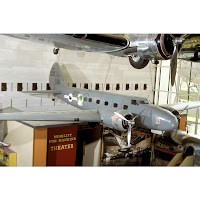This gallery contains airplanes from the formative years of air transportation in the United States. After 1926, the airlines were created to carry first the air mail and later passengers in regular service. With direct government support, together with a technological revolution that produced modern all-metal airplane by the early 1930s, air travel made tremendous progress in speed, safety, and reliability. By World War II, the United States had a well-developed modern network of air routes and airlines linking every state and reaching across the oceans.
- The Ford Tri-motor was the largest civil airplane in America when it started passenger service in 1926. The airplane's all-metal, corrugated aluminum construction and the prestigious Ford name made it immediately popular with passengers and airline operators. Noisy but reliable, the Ford Tri-motor played a major role in convincing the public of the safety and practicality of air travel.
- The Ford Tri-motor was powered by three 420 hp Pratt & Whitney 9-cylinder redial piston engines, providing the airplane with a maximum speed of 150 mph, cruising speed of 122 mph, service ceiling of 18,500 feet, and a range of 550 miles. Ford had built 199 of its famous aircraft and had flown by more than one hundred airlines in the world. It was developed from several earlier designs and became America's first successful airliner.
- The Pitcairn PA-5 Mailwing was designed to carry airmail along the routes of the eastern United States. It helped build the route structure for what would ultimately become Eastern Air Lines. The PA-5's good performance stemmed from three factors: a lightweight airframe; the reliable Wright J-5 engine; and the use of a Pitcairn developed airfoil, which permitted a relatively high top speed of 136 mph and also excellent load-carrying capability.
- The Mailwing was built in 1927. It combined a square-steel-tube fuselage with wooden wings covered by fabric and was the prototype for a series of Pitcairn mail planes.
- The Northrop Alpha represents a notable point of transition in modern airline design, for it combined features of the past and of the future in a very utilitarian package. The passengers were enclosed in a comfortable cabin, while the pilot remained exposed to the elements. The modern aspects of the Alpha were partially offset by the use of a single engine and fixed gear.
- John Northrop, who had previously designed the Lockheed Vega, conceived of the Alpha as a means of proving his ideas for quantity production of an all-metal airplane with the machine tools existing in the early 1930s. Always pioneering new ideas and new techniques, Northrop became one of the most influential men in the aviation industry.
- The Alpha was designed to be a high-performance plane that could carry mail and passengers out of small fields. The plane was attractive to airlines because of its comparatively high top speed (177 mph) and high reliability. The latter was due in large part to the use of the dependable air-cooled Pratt and Whitney Wasp engine of 420 horsepower.
- Although the Alpha served well, its real importance was its demonstration of Northrop’s multicellular wing and stress skin construction. These concepts were of fundamental importance to the DC-3. The Alpha began services in 1931 from San Francisco to New York with 13 intermediate stops. The entire trip took just over 23 hours.
- Developed in 1933, the Boeing-247 was an all-metal, twin-engine airplane, and the first modern passenger airliner. It had an autopilot, pneumatically operated deicing equipment, a variable-pitch propeller, and retractable landing gear.
- It took the Boeing-247 20 hours, with seven stops, to fly between New York and Los Angeles. Because the 247 flew at 189 mph, its trip was seven hours shorter than that made by previous airliners. The 247s remained in airline service until World War II, when several were converted into C-73 transports and trainers. Some were still flying in the late 1960s.
Douglas DC-3
- The most famous, most durable and probably most beloved aircraft in the history of aviation, the Douglas DC-3 marks its 74th anniversary of service in 2009. The development of the DC-3 was brought about by the commercial airlines demand for an economical passenger-carrying airplane. Up to early 1930s, airline passenger craft were too slow and carried too few passengers to be really profitable.
- In 1933 the Douglas Aircraft Company designed a new passenger plane, known as the DC-3, to compete with the Boeing 247. The DC-3 set a new standard for air travel and made it possible for airlines to make a profit in passenger service without government subsidies. The DC-3's streamlined, versatile design and strong wing construction made it an exceptional aircraft. As the success of the DC-3 was realized, airlines throughout the world began placing orders with Douglas. By 1938, 95 percent of all U.S. commercial airline traffic was on DC-3s.
- With the beginning of war production, variants of the DC-3 were designed as cargo and troop transports and were designated as the C-47 by the U.S. Army and R4D by the U.S. Navy. In the armed forces of the United Kingdom and many other countries, they were known as the "Dakota". The most spectacular and significant operation of C-47 took place on the eve of D-Day, when more than 1,000 C-47s were involved in dropping U.S. and British paratroops to areas behind the beachheads during Normandy Invasion.
- After World War II, General Dwight Eisenhower listed the C-47 as one of the four pieces of military equipment most vital to the Allied victory. Douglas had built more than 10,000 of them, for service in every part of the world. As the DC-3 approaches her 70th anniversary, more than 400 remain in service, including some 300 in military use. (Four things won the Second World War: the atom bomb, the bazooka, the C-47 Gooney Bird, and the Jeep,.)






